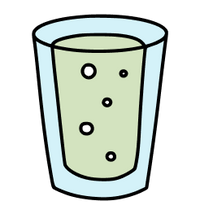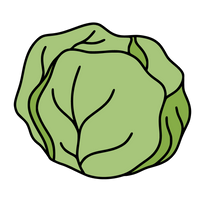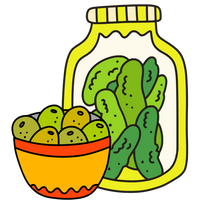
Is Pickle Juice Good for You?
Pickle juice is great for you! We’ve operated at farmers' markets for over 10 years, and recently we’ve created a “Free Pickle Juice Shot” station. It attracts a lot of people and is a major conversation starter. Almost universally, the notion of drinking pickle juice is intriguing to people. You might even be asking "is pickle juice good for you?"
Related post: Pickled vs Fermented. What Are the Best Pickles for Gut Health?

Should You Drink or Dump Pickle Juice?
From our extensive interactions, when it comes to drinking pickle juice, most people fall into one of two categories in how they see it.
The first type is incredulous that anyone would DO such a thing while reluctantly admitting that yeah, they’d like to try it. Basically, after they get used to the idea, they’re curious.
The second type is those that enthusiastically confirm that pickle juice is in fact amazing to drink. They confide they’ve been the oddball person in the house that’s been drinking pickle juice for years.
The most important thing to know is that most pickle juice is not created equal. We spend a good portion of time educating people about this.
Just like there are two camps of pickle juice opinions, there are two kinds of pickle juice: the "Drink It" kind and the "Dump It" kind.
You probably can guess that the healthy kind of pickle juice comes from fermented pickles, which contain naturally occurring probiotics. Unfortunately, most vinegar pickle juice doesn't fall into that category. Here’s more on that and the other reasons to opt for the live stuff.
The "Drink It" Kind: Fermented Pickle Juice
Fermented pickle brine (just like fermented pickles) contains loads of live, good-guy probiotic bacteria. At Olive My Pickle, we were really curious about this, so we sent a bunch of our products to a food microbiology lab to undergo ‘lactobacillus count’ testing.
We tested several products, including just the brine, and introduced several variables. The results were surprising and you can read all about this in our article How Do You Measure the Probiotics in the Products?
Our lab testing showed us that the brine came back with the highest amount of lactobacillus per serving size, of any of our products. The amount of lactobacillus CFUs (colony forming units, the unit of measure for bacteria) measured over 14 billion per 1.5 ounces (a standard shot glass amount.)
Dump It pickle juice? By comparison, it is dead, having been pasteurized. It's been pasteurized and contains no benefits of live cultures.
The "Dump It" Kind: Yellow Dye 5
Dump It Pickle juice often contains Yellow 5, also known as tartrazine or E102. So be extra careful before you start drinking from the pickle jar.
Yellow 5 and other artificial food dyes have been the subject of many studies. Whether or not they are a truly harmful food additive has been a highly controversial subject.
Here are where that controversy comes from and some facts for you to decide:
- An early 1973 study claimed a correlation between food dyes and hyperactivity in children. This garnered a lot of attention, and upon closer examination, there were some gaps found in the science that opened the question back up.
- Subsequent studies in the 1970s showed varying degrees of response by children when ingesting food dyes, many of them negatively affecting them and increasing hyperactive behavior.
- Other studies showed no adverse outcomes whatsoever when children consumed food dyes. (1)
- There were studies showing the causation of cancer and tumors in animals. These caused several European countries to ban food dyes. (2)
- More research showed a genetic predisposition by some children to have adverse effects, while others showed no noticeable adverse effects. In 2012, a study on Yellow 5, associated it with behavioral changes including irritability, restlessness, depression, and difficulty with sleeping. (3)
- In 2004, a meta-analysis (a scientific report on 15 studies) concluded that artificial food dyes do increase hyperactivity in children. (4)
- Despite all of this, the FDA and the EFSA have not shifted their stance from the 1970s, stating there is “currently not sufficient evidence to conclude that artificial food dyes are unsafe.” (5)
Here at Olive My Pickle, we will not blindly follow the FDA's lead and wait until "the science is in" to exercise our common sense and educate people about food dyes that are present in cheap pickles.
We speak with real people every Saturday at the farmer’s markets, many of whom aren’t aware of the potential harm of ingesting food dyes.
To learn more, search for ‘adverse health effects of Yellow 5’ and read the plentiful documentation for yourself. It’s an important area to study, we recommend it for anyone that eats. Read more about What Are The Best Pickles For Gut Health.
Sports Drinks vs. Probiotic Pickle Juice
Is pickle juice better than sugary sports drinks after a workout? Pickle juice may be one of the best-kept secrets in the fitness world.
In one word, YES. We’ve picked the top three reasons to avoid those colorful ‘sports recovery’ drinks.

Sports Drinks are Full of Sugar
First, they are chock full of sugar. Check out these facts:
- A 20-ounce serving of Gatorade's Thirst Quencher contains 36 grams of sugar. That's a bit less sugar per ounce than your average soda, and in fact, Berkeley researchers say the sugar in sports drinks may be contributing to the child obesity epidemic by increasing caloric intake. (6)
- A 32-ounce bottle of Powerade has 221 calories and 55 grams of carbs - all from sugar.
- Endurox R-4 (Fruit Punch flavor), which is marketed as a more science-based recovery solution contains 360 calories and 69 grams of carbs. That’s equivalent to eating 33 Tootsie Rolls!
Sports Drinks Impact Dental Health
The second reason to steer clear of sports “ades”: dental health.
A 2005 study in General Dentistry found that some sports drinks were more destructive to teeth than cola. In the study, they took a look at how much damage different types of beverages did to the tooth enamel. The researchers found that enamel damage was 3-11x times greater for non-cola and sports beverages than for cola-based drinks. (7)
Sports Drinks May Have Food Dyes
The third reason to never drink Gatorade again? Food dyes. We explained the history of food dyes and their potential impacts earlier in this guide.
Bottom line, food dyes, including the ones found in Gatorade and Powerade have a long history of science-backed research that correlate problems of food dyes, including behavior problems in kids, and tumor growth and cancer in mice. (8)
What Are the Health Benefits of Pickle Juice?
Have you been hearing about your favorite sports team drinking pickle juice now instead of Gatorade? What about other health benefits of pickle juice?
Pickle Juice and Electrolytes
Electrolytes are essential minerals—like sodium, calcium, and potassium. All of which are vital to many critical functions in the body.
These minerals carry an electric charge when they are dissolved in a liquid such as blood. Whenever you hear the word ‘essential’ describe something nutritionally, it means your body must have it and cannot produce it on its own -s o you have to put it in, either with food or supplements.
Why is this important?
These electrolytes help regulate nerve and muscle function, maintain the acid-base balance (your body’s pH level), and make sure your fluid levels are correct in your body.
This process is called ‘water balance,’ and it’s the reason you hear about it why electrolytes are responsible for rehydration.
What are the benefits of electrolytes in pickle juice?
An often-overlooked benefit of consuming healthy probiotic pickle juice is the high electrolyte load contained in the sodium and potassium within high mineral sea salt brine.
Your body loses electrolytes when sweating and the foods you eat replace them. Healthy pickle juice is very effective in rehydrating your body - and not just for Olympic athletes.
Try drinking a shot of pickle juice after you finish working in the yard and see how much more replenished you feel.
Pickle Juice and Probiotics (Good Bacteria)
Think you have to pop a probiotic supplement to get probiotics? Not so.
Drinking pickle juice from fermented pickles contains loads of lactobacillus bacteria - this "good-guy" good bacteria is a really good source of bacteria to promote a healthy gut.
A 1.5-ounce serving (that’s a shot glass size) of our pickle juice contains 14 billion colony-forming units of live culture bacteria. Many of our customers tell us the health benefits of pickle juice they experience when they take shots of pickle juice each day.
Our products are third-party lab tested and verified to contain probiotics.
Pickle Juice Helps Muscle Cramps
In a 2014 study where pickle juice was effective for muscular cramps, researchers found that it should be about 1 milliliter per kilogram of body weight. So for an average person, this will be between 2 to 3 fluid ounces (a shot glass is 1.5 ounces, so 1 or 2 of those). To use pickle juice for muscle cramping, measure out the pickle juice and drink it quickly. Taking a rough “shot” is also acceptable. (9)
At Olive My Pickle, we have been having conversations with our community of customers for 10 years about the benefits they experience when drinking our pickle juice. We can confidently state from a decade of anecdotal evidence: drinking pickle juice has a positive effect on muscle cramps and muscle cramping and is a natural way to address this problem.
Quality of Salt in Pickle Juice
The third superpower of “Drink It” pickle juice is the quality of sodium it contains, which comes from high-mineral sea salt.
While many of us have been trained to believe that “all sodium is bad”, the fact is that sodium is an essential nutrient your body needs to properly function. And just like anything else you eat (sugar, fat, protein, calories), the quality of the sodium is as important to consider as the quantity.
Drink It pickle juice contains high-mineral content sea salt. It is far less processed than iodized table salts. By contrast, high mineral salt also contains a number of minerals, including zinc, iron, and potassium. By contrast, Dump It pickle juice derives its sodium from cheap, low-quality, industrialized vinegar, which has high acetic acid and is therefore rough on the digestive tract.
Pickle Juice Curbs Sugar Cravings
Avoid blood sugar spikes and address those late-night sugar cravings by opting for a healthy, salty snack instead. A shot of pickle juice is a zero-calorie way to do both and a great option for those trying to lose weight or simply maintain a healthy body weight.
Concerned about sodium count or on a low sodium diet? A shot glass size (1.5 ounces) of pickle juice contains just 176 mg of sodium (which makes it a great low-calorie alternative snack if you’re craving salt).
How to Use LiveBrine for a Gut-Healthy Probiotic Boost
Now that we've answered the question "is pickle juice good for you" and you know the benefits of pickle juice it's time to get this probiotic boost into your life!

Here are a few quick and overlooked ways:
- Rise & Brine. Start your day with a shot.
- Drink to rehydrate post-workout.
- Add into any salad with extra virgin olive oil or whip up a dressing.
- Use as a marinade to tenderize and flavor (pickled chicken).
- Splash on salsa, blend into any sauce or dip.
- Brush on grilled veggies as a salt substitute.
- Mix into a cocktail or mocktail.
- Blend into a fruit smoothie or juice.
The ultimate quick start: Our The Big LiveBrine Bundle - 6 Pack is one of our customer's favorite ways to get started with this healthy habit. Containing our two best-selling flavors of LiveBrine Probiotic Pickle Juice: Classic Kosher Dill and LiveBrine Probiotic Pickle Juice: Turmeric & Cracked Black Pepper as well as the perfect 1.5-ounce "Rise and Brine" shot glass so you never forget to hydrate.
In conclusion: Drink healthy pickle juice. Know the difference. Choose the good stuff. Build your box today.
References
- https://www.ncbi.nlm.nih.gov/pmc/articles/PMC3441937/
- https://pubmed.ncbi.nlm.nih.gov/366539/
- https://pubmed.ncbi.nlm.nih.gov/23026007/
- https://pubmed.ncbi.nlm.nih.gov/7965420/
- https://pubmed.ncbi.nlm.nih.gov/15613992/
- https://www.issuelab.org/resources/18583/18583.pdf
- https://www.sciencedaily.com/releases/2012/05/120501134319.htm
- https://pubmed.ncbi.nlm.nih.gov/15613992/
- https://meridian.allenpress.com/jat/article/48/6/734/111379/Ad-Libitum-Fluid-Intake-and-Plasma-Responses-After











